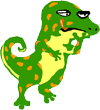
|
|
|
|
Japan Horseshoe Crab Conservation Association

You can observe an adult horseshoe crab in the tank. Adult horseshoe crab does not have a lot of predators or enemies in the ocean. On the other hand, young crabs were vulnerable to predators such as herons, crows and octopuses. Craws are good at flipping the young horseshoe crab upside-down to peck the soft parts. |
The Horseshoe crab is famous as “living fossil”. In Japan the crab ranges from the shore of Okayama, Hiroshima, Ehime, Yamaguchi, Oita, Fukuoka and Saga to Nagasaki prefecture. You may be lucky if you spot them because their habitats are shrinking. Mudflat is very important for the crab and other wildlife for habitat, though mudflat have been disappeared by coastline developments or pollutions. In 1978, Japan Horseshoe Crab Conservation Association was established to educate people the importance of horseshoe crab and its conservation. The general office is in Kasaoka city in Okayama, and the offices are in Ehime, Fukuoka, Satsuki city in Oita and Imari city in Saga. The association has increased the members gradually, now more than 700 of the registered members to study the life of horseshoe crabs and conserve mudflats together with local volunteers. 
|

President of the Conservation Association Mr. Tsuchiya

The larva was found on the wild mudflat (at the centre of the photo). Take a close look to see the clear foot trace on the mud. The Association has been releasing the larvae and conducting the monitoring of adult horseshoe clubs. They found some adults previously released to the wild. (Image was provided by Kasaoka City Horseshoe Museum)
Horseshoe crab eating warms |
Keiji Tsuchiya, the president of Japan Horseshoe Crab Conservation Association, has worked on the conservation since 1961. At the beginning not much help he could get, he had to help dying crabs one by one with medical doctor Hiroyuki Nishii, who was the leading conservationist back then. At that time the mudflats were rapidly reclaimed for development. It was hard to protect almost vanishing crabs in that situation. Moreover the ecology of horseshoe crab was hard to understand and rearing crabs was even more. From point of human side horseshoe crabs were troublesome for fishermen because the crabs easily broke their fishing net. Tsuchiya patiently explained why it was important to protect horseshoe crabs and its habitat with Dr. Nishii. “Horseshoe crabs are very cute to me. I feed them in the morning. They swim upright and stick themselves on the tank glass to wait for me. They eat warms directly from tongs with their mouths which open under their shells. After the meal they keep circling around the tank as if they show their appreciation. That is fascinating,” said Tsuchiya. Needless to say, Tsuchiya loves horseshoe crabs so much, even his tie clip is the shape of horseshoe crab. He also gave opportunities to local high school students to get involved to protect the habitat and study on the breeding of the crab. Not only that, they had collected the crab carcasses to make specimens that children could observe and understand body structure of the crab. |
|
“It was not easy to rear and breed horseshoe crabs when we started, but the project had been progressed successfully. The city and local volunteers tried to improve the water quality with upgraded sewage disposal facilities”, said he. But there is still something to be concerned. The mad condition has changed to unsuitable for crabs to grow because tide move differently after land reclaiming. “Their shells were used to be thicker and harder. They moved more vigorously. After all they were more energetic. Probably the quality of mud affects their eggs and growth, but we do not know the exact reasons yet.” Tsuchiya cannot be optimistic about the future of horseshoe crabs and its environment. “We made some progress though. Now fishermen release the crabs which have been caught in their net by mistake. We also plant marine plants in which small crabs inhabit and hide.” Takahashi still has hope for horseshoe crab conservation. |

Artificial beach for horseshoe crabs to lay eggs. The beach is placed beside Kasaoka City Horseshoe Crab Museum. The seawater flows in directly from the ocean. A female horseshoe crab lays 200 to 300 eggs in one place at a time. |

|

Protect our horseshoe crab! Keep our city clean! |
Kasaoka-city Horseshoe Crab Museum
Horseshoe crab
|

|
In 2003, City of Kasaoka established by-law to protect the horseshoe crabs. |
 Kasaoka-City Horseshoe Crab Museum was constructed beside the cove, opened in 1990 along with Dinosaur Park.
Kasaoka-City Horseshoe Crab Museum was constructed beside the cove, opened in 1990 along with Dinosaur Park.

Huge Baryonyx replica, the display recreates the landscape of the world 200 million years ago when the horseshoe crab appeared. |

The world oldest horseshoe crab was excavated in Bolivia in Africa. It is said that the fossil is about 390 million years old during the Devonian period in Paleozoic Era. The image above is the trilobites which are biologically related to horseshoe crabs. |

After the eggs have been collected from the artificial beach, those are transferred to the incubation room. Each container has different age crabs and several mud which is taken directly from the beach nearby, so the condition is similar to the wild. |
Norimichi Souji, chief curator of the museum, helps that the horseshoe crab population grows in the wild. “We release about 1,000 of juvenile crabs into wild every year. I hope we could see them on the shore all the time, just like we did years ago and someday children can enjoy the life of the beach with horseshoe crabs” said Souji. 
Juvenile after 5th molt |

Many local people joined the moment to release the juvenile crabs into the wild beach of Kasaoka city.
The crabs were 6th or 7th molted. Souji prayed for their future.

The horseshoe crabs above are from the USA. They have larger eyes on their carapace than Japanese do. Horseshoe crabs live in China, Taiwan, The Philippines, Indonesia, Bay of Bengal in India, the east coast of the USA, and so on. |
“It is not easy to recognize all individuals particularly. There are so many of juvenile crabs here, but still I can identify some of them, because each has different face and the carapace shape, and personality. Some are vigorous during the meal time and pushing others from food, while some are quiet”, said Souji as if he is the father of all. Even though he kept studying on their behavior and ecology for 26 years, so many things are still unknown. “First of all, we don’t know about their food. We feed warms and squids to the crabs in this museum, but there is no clear answers what they actually eat in the wild. Somehow we gradually understand their behavior in summer, but we have no idea about them in winter,” said Souji. While the ecology of the crabs is still needed to study, he visits local communities to talk about his experience and knowledge of the crabs to send message of how fascinating the crabs are. |
|
By the way, why is it important to protect horseshoe crabs? “They are the perfect indication of the health of the environment. There are many fish, shrimps, crabs, and other creatures in the sea where horseshoe crabs inhabit. We all know that they have been on the earth for 200million years. They have adapted themselves to the alternation of environment for such a long time. They are the treasure.” Souji thinks that we should know how horseshoe crabs are related to the other animals in the beach and the ocean while we protect them. |

Cast-off carapace of horseshoe crab. Molting is critical moment for horseshoe crab. Unlike crabs, horseshoe crabs molt not only the carapace but also the viscera. Unfortunately some cannot survive the molting. |

|
The drags contains the ingredient taken from horseshoe crab’ blood. It is effective to cure the infection of e-coli O157 and dysentery. |
To the next generations
 Director Asano hopes the beautiful sea of Kasaoka for the next generations. |
|
It is very important to keep the ideal environment for the conservation of horseshoe crabs. Of course it is not only for the crabs but also for the other animals and humans sharing the same environment. “I want people not to do pleasure shellfish gathering in the conservation site. Digging mudflat is harmful for the larvae and also deteriorates the mudflat ecology”. Asano ask the people to understand. Cruising ships lift sand from the bottom of sea and the sand flows into the pits dug up by pleasure shellfish gathering to cover the mudflat. Sandy beach is not suitable for the larvae to glow. He has got corporation from shipping companies to slowdown the cruising, but still 400 to 500 visitors come here for shellfish gathering. It is not easy to get people to understand the effort of Kasaoka city because many of them are from outside city. So during the summer season, local volunteers come to the entrance of the conservation site to ask the visitors not to do gathering with some enlightening handout. |
|
“I understand family pleasure is important. All parents want to give their children the opportunities to play on the sea shore together. But I believe protection of the seashore where horseshoe crabs inhabit is very important as well. The nature will be richer gift for us when we looked at not only the present but also the next generations”, Asano said. He wants to find the good balance to share the same environment with human and animals. 
|
 Male horseshoe crab molt 15 times while female molt 16 times to glow in 13 to 14 years.
Male horseshoe crab molt 15 times while female molt 16 times to glow in 13 to 14 years.
|
Stretching out the conservation
 The visitors can observe the rearing in the laboratory.
The visitors can observe the rearing in the laboratory.
|
It has been reported the most breeding sites is Sone mudflat in Northern Kyushu and Imari Bay is the next. So Kyushu University and Imari Senior High School have been conducting the research. In Shikoku, there is “Horseshoe Crab Festival”. Kitsuki-city in Kyushu set the display about horseshoe crabs to educate people at the local commercial festival. Moreover, the city exchanges information and has some events with the cities of USA, China and India. 
|

Beautiful cove in Kasaoka-city. The fishers caught halfbeak fish and octopus that day.
The domed building on the left of this photo is Kasaoka-City Horseshoe Museum.